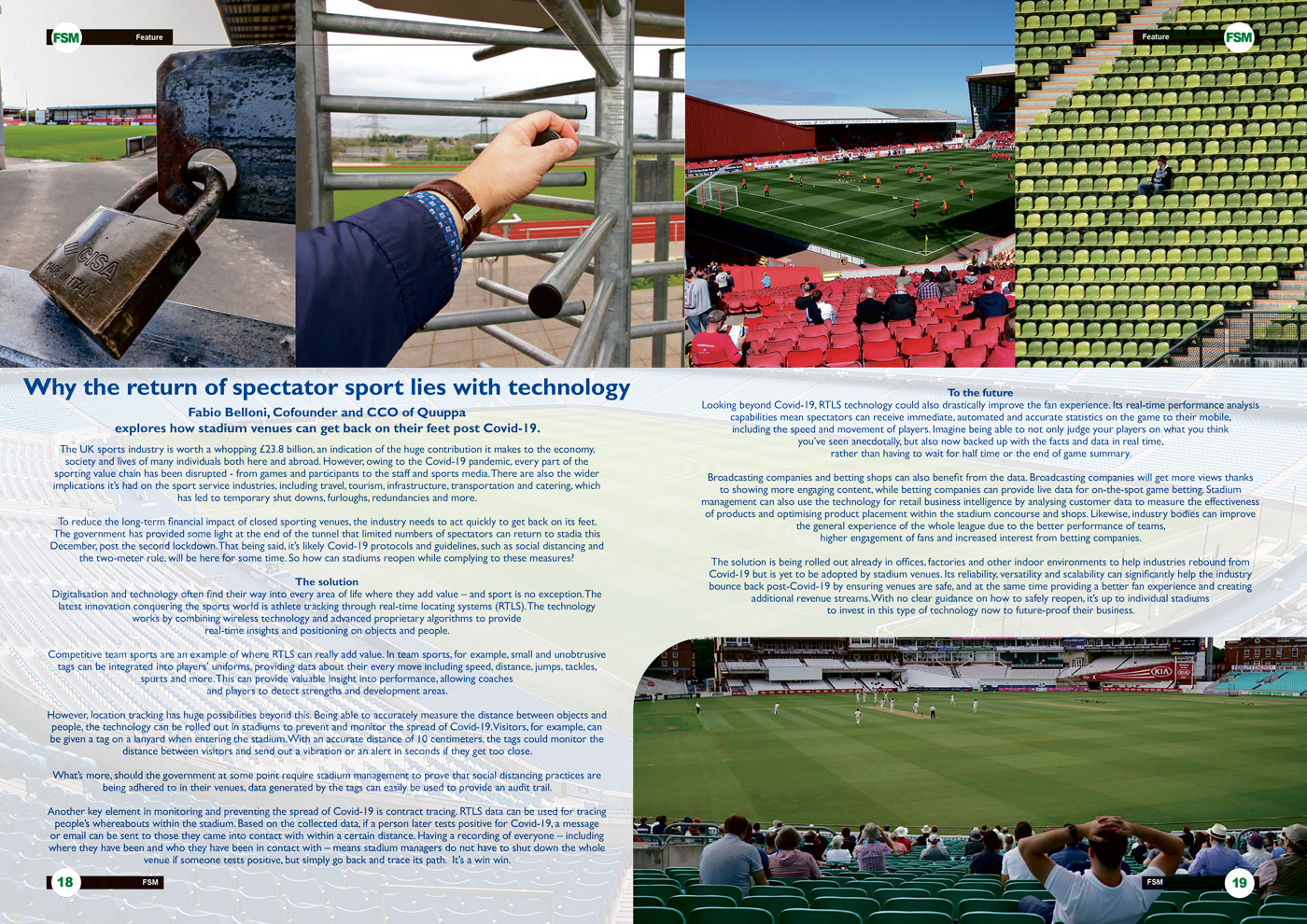Why The Return Of Spectator Sport Lies With Technology
 Fabio Belloni, Cofounder and CCO of Quuppa explores how stadium venues can get back on their feet post Covid-19
Fabio Belloni, Cofounder and CCO of Quuppa explores how stadium venues can get back on their feet post Covid-19
The UK sports industry is worth a whopping £23.8 billion, an indication of the huge contribution it makes to the economy, society and lives of many individuals both here and abroad. However, owing to the Covid-19 pandemic, every part of the sporting value chain has been disrupted - from games and participants to the staff and sports media. There are also the wider implications it’s had on the sport service industries, including travel, tourism, infrastructure, transportation and catering, which has led to temporary shut downs, furloughs, redundancies and more.
To reduce the long-term financial impact of closed sporting venues, the industry needs to act quickly to get back on its feet. The government has provided some light at the end of the tunnel that limited numbers of spectators can return to stadia this December, post the second lockdown. That being said, it’s likely Covid-19 protocols and guidelines, such as social distancing and the two-meter rule, will be here for some time. So how can stadiums reopen while complying to these measures?
The Solution
Digitalisation and technology often find their way into every area of life where they add value – and sport is no exception. The latest innovation conquering the sports world is athlete tracking through real-time locating systems (RTLS). The technology works by combining wireless technology and advanced proprietary algorithms to provide real-time insights and positioning on objects and people.
Competitive team sports are an example of where RTLS can really add value. In team sports, for example, small and unobtrusive tags can be integrated into players’ uniforms, providing data about their every move including speed, distance, jumps, tackles, spurts and more. This can provide valuable insight into performance, allowing coaches and players to detect strengths and development areas.
However, location tracking has huge possibilities beyond this. Being able to accurately measure the distance between objects and people, the technology can be rolled out in stadiums to prevent and monitor the spread of Covid-19. Visitors, for example, can be given a tag on a lanyard when entering the stadium. With an accurate distance of 10 centimeters, the tags could monitor the distance between visitors and send out a vibration or an alert in seconds if they get too close.
What’s more, should the government at some point require stadium management to prove that social distancing practices are being adhered to in their venues, data generated by the tags can easily be used to provide an audit trail.
Another key element in monitoring and preventing the spread of Covid-19 is contract tracing. RTLS data can be used for tracing people’s whereabouts within the stadium. Based on the collected data, if a person later tests positive for Covid-19, a message or email can be sent to those they came into contact with within a certain distance. Having a recording of everyone – including where they have been and who they have been in contact with – means stadium managers do not have to shut down the whole venue if someone tests positive, but simply go back and trace its path. It’s a win win.
To The Future
Looking beyond Covid-19, RTLS technology could also drastically improve the fan experience. Its real-time performance analysis capabilities mean spectators can receive immediate, automated and accurate statistics on the game to their mobile, including the speed and movement of players. Imagine being able to not only judge your players on what you think you’ve seen anecdotally, but also now backed up with the facts and data in real time, rather than having to wait for half time or the end of game summary.
Broadcasting companies and betting shops can also benefit from the data. Broadcasting companies will get more views thanks to showing more engaging content, while betting companies can provide live data for on-the-spot game betting. Stadium management can also use the technology for retail business intelligence by analysing customer data to measure the effectiveness of products and optimising product placement within the stadium concourse and shops. Likewise, industry bodies can improve the general experience of the whole league due to the better performance of teams, higher engagement of fans and increased interest from betting companies.
The solution is being rolled out already in offices, factories and other indoor environments to help industries rebound from Covid-19 but is yet to be adopted by stadium venues. Its reliability, versatility and scalability can significantly help the industry bounce back post-Covid-19 by ensuring venues are safe, and at the same time providing a better fan experience and creating additional revenue streams. With no clear guidance on how to safely reopen, it’s up to individual stadiums to invest in this type of technology now to future-proof their business.
Click the article to enlarge it.











































